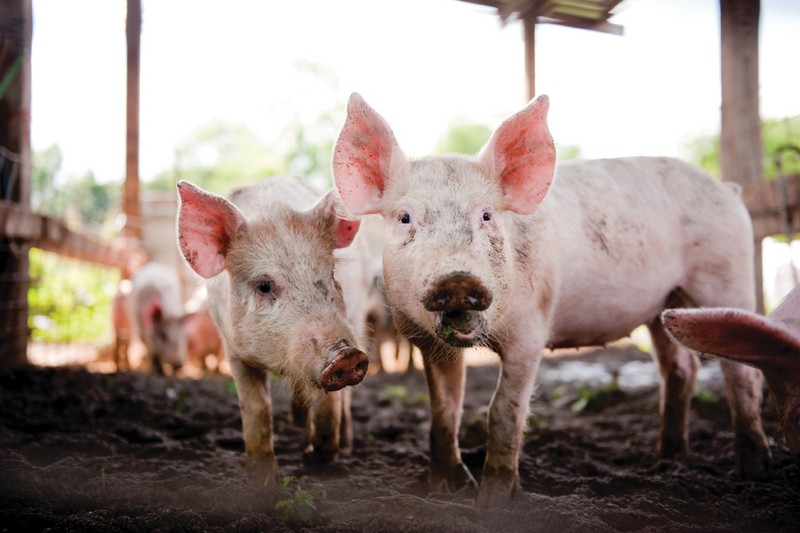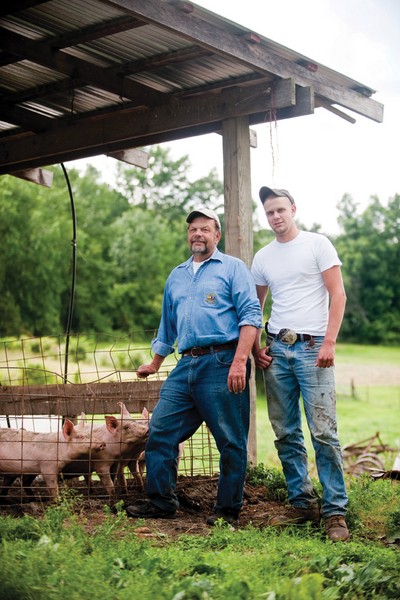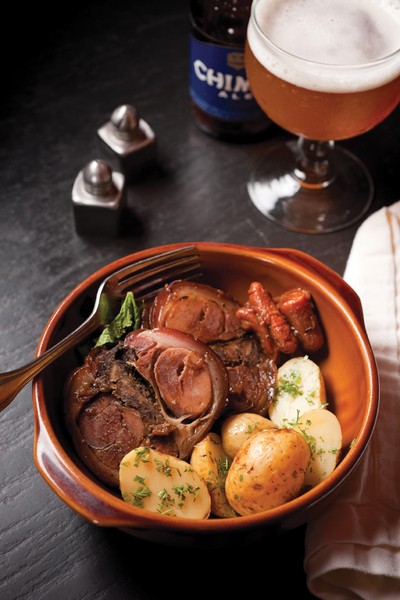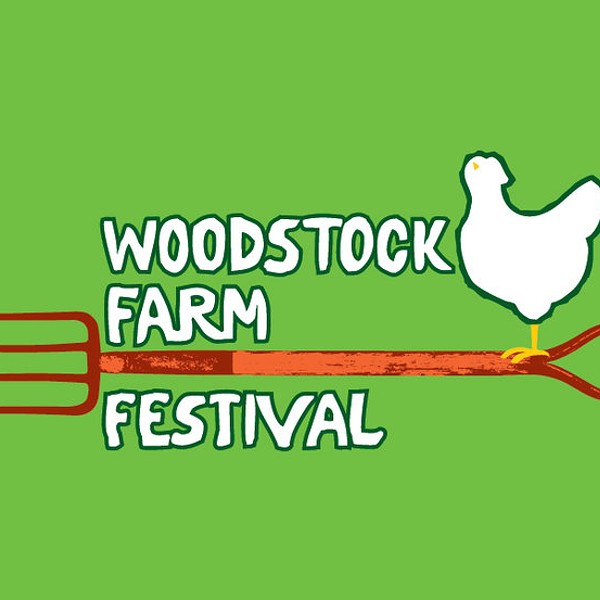The pig first evolved in Asia around two and one half million years ago before extending its habitat north into Russia and Japan and west into India, Mongolia, Central Asia, Iran, Iraq, Turkey, and eventually into Europe. Fossil remains of the earliest swine indicate there existed both pigs with a vegetarian diet and those with a decidedly more omnivorous palate, which sometimes included carrion and humans. This unscrupulous scavenging undoubtedly contributed to the pig’s unfortunate reputation even at the dawn of civilization—although they existed in Ancient Egypt, there are no paintings of pigs to be found in Egyptian tomb paintings—and subsequent banishment from the Jewish and Muslim diet. The pig, a member of the Suidae family, encompasses 16 species of pigs and hogs in eight genera, including the modern domestic pig—Sus scrofa or Sus domesticus. Generally, pigs are divided into two races—the white, so-called Celtic pigs, which include all of the familiar northern European and American pigs, and the black such as the iberico. The fat of the black pig is naturally rich in monosaturates and when fed the right diet combined with exercise, it develops a lot of intramuscular fat which makes for tasty meat. White pigs lack this propensity for both intramuscular fat and monosaturates.
The whole hog
Despite popular conjecture, snout-to-tail eating (that is, utilizing all parts of the pig for food) is not something that current locavores, slow foodies, the environmentally conscious set, or the new generation of farmers have recently discovered. Ancient Romans were joyous ingestors of pig; some bits—such as pig vulvas and teats (no account of patrician Roman banquets fails to mentions these)—are still too racy for today’s porcine renaissance. Ancient Greek culinary repertoire indicates the allantoupoles or specialist prepared dishes like roast suckling pig, fattened on grapes and stuffed with herbs that are quite similar to modern charcuterie. The modern meat eating world of post-industrial America can lay claim to the ignominious fact of being the first of several generations disdainful of whole pig (or cow or sheep or goat, for that matter), opting for luxury cuts of chop, cutlet, loin, round, brisket, butt—cuts cited as least flavorful.
Snout-to-tail eating, championed by several Hudson Valley farmers and chefs, favors a world view that is one part environmental—“eating the whole animal is certainly a smaller footprint,” says Rich Reeve of Elephant wine and tapas bar in Kingston—and one part economical; obscure cuts are less desired, and thus less expensive. Nearly every single farmer and chef swoons over pig fat. “Pork fat rules,” says Reeve. “The Chinese call pig belly the ‘five layers of heaven’ because it is meat-fat-meat-fat-skin.” Roasted pig bellies are really popular at the Country Inn in Krumville, according to chef Spencer Mass. Chef Rei Peraza, executive chef at the Rhinecliff Hotel, loves pig fat for its flexibility. “Cure it, slice it paper-thin, and serve it over anything, warm toast, a piece of scallop,” he says. “Pig fat’s melting point offers great mouth feel in pates and sausages. Braised pork belly has awesome richness and depth of flavor.” Josh Applestone, owner/butcher at Fleisher’s Grass-fed and Organic Meats in Kingston, favors pigs’ feet slow cooked “forever and ever so they become beautiful globs of fat and skin.” Jeffrey Gimmel of Swoon Kitchenbar in Hudson salt-cures pig belly first, then confits it in duck fat for hours so the belly “ends up incredibly luxurious and succulent.”
Inherent in snout-to-tail is the old-fashioned prudent fiscal ethos, creative in a pioneering, intelligent manner and the antithesis of consumerist reliance on replacement instead of imaginative and alternative use. Farmer Carol Clement of Heather Ridge Farm in Preston Hollow says that historically, pigs were essential for providing fresh meat, meat for curing, and versatile pig fat to preserve meat or make soap. “New trend? Hardly,” says farmer Denise Warren of Stone and Thistle Farm in East Meredith. “The rest of the world has been eating the whole animal for centuries. Only gluttonous Americans have the luxury of eating the chops and not worrying where the rest of the animal goes.”
“Complete pigs offer such a variety of flavors, textures, and techniques, making for a true gastronomic experience,” says Peraza. “The history of pigs within different cultures offers an interesting look into the survival of these cultures. What would we have done without the pig, salt, and fermentation?” Chef Josephine Proul of Local 111 in Philmont recalls her grandfather’s post-holiday tradition of “putting whole leftover hambones into the meat sauce and brewing it for hours on the stove until the meat was all stripped away from the bone and the sauce was meaty and rich.” At Swoon, headcheese terrine and guanciale (jowl) terrine appear regularly on the menu, and Gimmel sources local because “of the real joy in having to buy the entire hog, not just one or two prime cuts. Figuring out how to utilize and make every last piece delicious is a labor of love.” The curious gastronome might readily venture forth into uncharted pig territory at a restaurant but the implementation of snout-to-tail eating at home lags behind. “Pig trotters are not in mainstream demand, although we do get a lot of culinary kids asking for the off-parts,” says Fleisher’s Applestone. “We need people who are not afraid to try pig’s ears or cheeks. Don’t yuck the yum until you’ve tried it. In our store, no one’s allowed to yuck the yum.”
Some pig
Hudson Valley pig farmers raise their animals primarily on pasture, supplemented with organic grains in winter, without any antibiotics or other drugs. Pigs, with only one stomach as opposed to the bovine two-stomach system, metabolize fat differently; they do not process the fat they eat in a second stomach. Ruminants digest things twice, transforming fat into hard hydrogenated and saturated fat. For example, a pig that eats peanuts will deposit the fat as peanut oil, soft fat, which is the reason that pig fat has more of the subtle flavors of acorns, peanuts, soybeans, corn, or pasture grasses that the animal consumes. (In the United States, industrially produced pigs are usually fed a “hygienically produced” diet of ground-up viscera and fish meal, thus inhibiting factory-farmed pig flesh from tasting sublime.) Local farmers frequently raise heritage breeds like Tamworth, Gloucester Old Spot, Landrace-Durocs, or Berkshire, pigs that are naturally capable of living off the land with minimal supervision.
Some farmers, like Clement, prefer to process (not slaughter, as this is regulated by the government and requires an inspected kill in a USDA-approved slaughterhouse) the pigs on their farm in order to “get all of the funny bits the slaughterhouses aren’t set up for like tails, ears, heads.” A licensed kitchen allows Clement to offer pig lard, pig tails (“mostly fat around a bone; use it like a wand for greasing pans”), pig ears, nitrate-free bacon, pate, and seven varieties of pork sausages: hot and sweet Italian, Asiago, garlic and parsley, breakfast, Tuscan sun-dried tomato and herb, kielbasa, Irish bangers, and chorizo.
Warren and her husband raise Tamworth and Berkshire pigs on pasture, in woods, and fields. The pigs also eat certified organic grains and tons of goat milk, gallons of whey and expired organic products or “flopped” dairy products like yogurt, Skyr (Icelandic yogurt), cream, milk, and crème fraiche—the pigs’ favorite. “These are pigs with great taste and panache,” says Warren. The Warrens’ pigs truly work for them, using their strong snouts as rototillers to turn over the compost pile and the pumpkin fields, cleaning up the unharvested squash and greens.
At Northwind Farms Richard and Jane Biezynski raise about 100 pigs—a selection of Berkshire, Berkshires crosses, Yorkshires, Landraces, Hampshire, Hampshire crosses, Tamworths, and Gloucester Old Spots—on 196 acres in Tivoli. “When it comes to feeding, I’m not going to give up my secrets,” Richard says. “Yes, our pigs are out there in the open, on pasture. There are pigs all over the place, even down by the pond, where I don’t want them.”
Fleisher’s has the capability to process six to eight Landrace-Duroc crosses a week, thus requiring many animals on the ground. “First and foremost, we are governors of the land and don’t want to overwhelm the land,” says Applestone, who sources pigs from three Mennonite families in Pine Plains who divide the work. One family grows silage corn, another handles breeding, and the third pastures and finishes. The inspection of the farm doesn’t matter as much as Applestone’s final inspection—on his butcher’s table. “I love pig. I appreciate good meat, good animal husbandry, healthy color, strong musculature,” he says. “And, being a surgeon, when I get the pig up on the table I know what’s what.”
Forget pork chops
The pig parts discussed with affection by Hudson Valley chefs are jowls, trotters (the forearm or foot of the animal) ears, hearts, bellies, and cheeks. Chef Peraza is currently working with Ossabaw, a breed that is a direct descendant of the black Spanish pig that was introduced to the Americas via the Mid-Atlantic coast. The pig’s debut in the New World can be traced to Christopher Columbus’s second voyage (1492-1496), via the ship’s manifest that lists eight iberico offloaded in Cuba. (The pig arrived on the North American mainland in 1539 when Hernando de Soto commenced his explorations through the southeast with 13 animals that he’d rounded up in Cuba.) Peraza’s menu has included warm chicory salad with fingerling potatoes, pickled pearl onions, bacon vinaigrette, and crisp pig ear confit. “We braise the ears in white wine and aromatics, coat them in barley flour, and fry them crisp to toss with rest of the ingredients,” he explains. “Garnish is a poached duck egg.” Another dish, pig’s foot en gelee with horseradish and black truffle foam, is made by “braising the pig’s foot in Gewürztraminer, clarifying the braising liquid and infusing it with horseradish juice then setting the pulled pig’s foot en gelee and topping with a foam made with Oregon black truffles.” Peraza’s favorite way to eat pig? “Serrano ham, straight up,” he says. “Just bread, ham, and olive oil and pernil [a small whole pig or, more commonly, a leg marinated with garlic, cumin, onions, and sour orange juice and slow roasted in a pit].”
At Elephant, the board says “Swine is Fine.” The swine of the week features a changing selection of imported and local charcuterie such as chorizo (Spain), lomo embuchado (Spain), sopressatta (Italy), and jamon serrano (Spain), which can be ordered singly, doubly, or as a triumvirate and served with Spanish marcona mustard, black fig jam, pickled cucumbers, and Spanish almonds dusted with Moorish spices. Reeve also creates his own porchetta (Italian for roast suckling pig) by roasting it long and slow to crisp up the skin to offer it on a baguette with fresh rosemary. Frittatas of pig ear and spring onion or guanciale have been specials. Reeves composes pate with ground pork liver and pork sausage, the entire glorious thing wrapped in bacon. This winter, Reeve featured pork belly confit with watermelon and white beans and a soup made from clams and pig trotters.
At the Country Inn, Spencer Mass creates pig dishes from trotters, hocks, heads, cheeks and ears, primarily in autumn and winter. Mass stuffs the trotter [the forearm or foreleg, which can include the hoof or foot] from knee to ankle. “I bone it out, leave the skin on,” he says. “Then I stuff it with vegetables or with a pork farce, a forcemeat made from the meat of the same animal, maybe from shoulder. [Then] roll it, tie it, and cook it very, very slowly for a long time.” Mass has garnished bitter greens with slow-cooked, fried pigs ears. Mass has his own porchetta, which uses a whole leg even a whole pig. He bones out the entire animal and cooks it similar to a stuffed trotter but larger. “I cook it in a dry heat and roast it slowly. We also do a whole hog dinner every fall. We’ve done pig heart salad, grilled pig tongue but dishes like these are a small part of our menu. People that are in the know, order them and enjoy. The rest of the people just ask about it.”
In Rhinebeck, Wilson Costa at Gigi Trattoria buys whole and half pigs from Northwind Farms and then butchers them. Some of the cuts retail at Gigi Market; others make their way onto the restaurant’s menus. Wilson fills Gigi’s paper-thin homemade ravioli with pork cheeks and makes cotechino, a fresh pork sausage using the cheeks and hamhock, a traditional dish from Modena that he serves with braised lentils. Braised pig belly agrodolce, Italian sweet and sour style is also available. “People love pig,” says Pensiaro. “Any pork special, no matter the cut, sells out.”
Josephine Proul at Local 111 incorporates house-cured hamhock with sauerkraut, potatoes, and braised pork belly. Proul sources local pig from Sir William Farm in Hillsdale (“really good bacon,” she says) and whole hog from Ry Ky Ranch, which is five minutes away from the restaurant. Other pig dishes at Local 111 include braised pork Cubano and pork sausage made every week for savory applications like pastas and breakfast dishes.
In Delaware County, the Warrens transformed an architect’s error of scale during kitchen renovation into a delicious paean to farm to table dining: Fable, their on farm restaurant. There, the pigs go a distance of a few hundred feet from field to fork. Fable serves pig jowls with a black-eyed pea chili and prepares guanciale with Kosher salt, sugar, garlic, peppercorns, and thyme.
Pig in the Hudson Valley celebrates whole local pig. “It’s all about the off-cuts of pig,” says Reeve. “It’s where the new flavors are—how many ways can you have a pork chop?”
The Country Inn www.krumville.com
Elephant www.elephantwinebar.com
Fleisher’s Grass-fed and Organic Meats www.grassfedmeat.net
Gigi Trattoria www.gigtrattoria.com
Heather Ridge Farm www.heather-ridge-farm.com
Local 111 wwww.local111.com
Northwind Farms www.northwindfarms.com
The Rhinecliff www.therhinecliff.com
Stone and Thistle Farm www.stoneandthistlefarm.com
Swoon Kitchenbar www.swoonkitchenbar.com



















